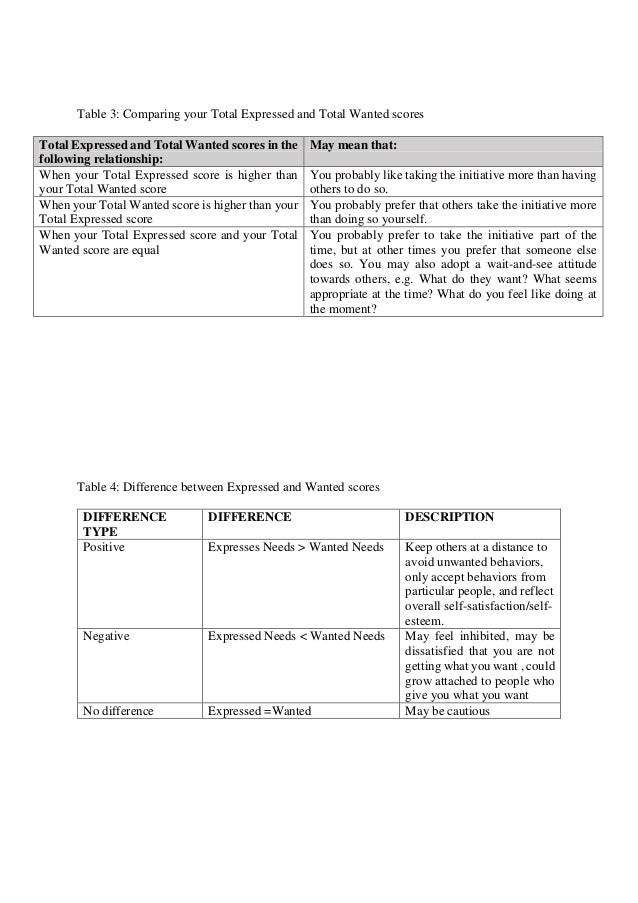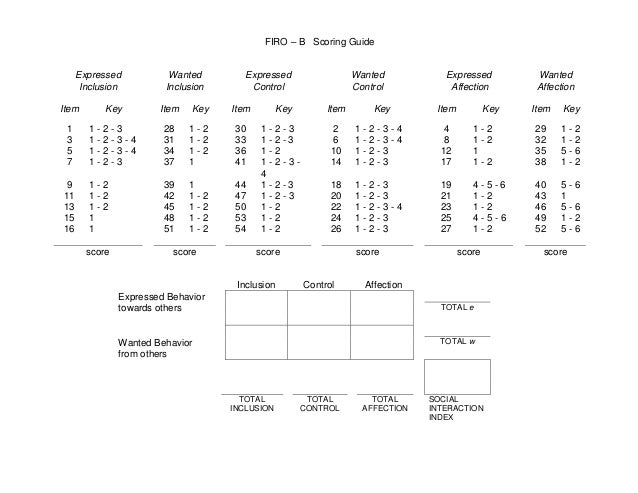Free Firo B Questionnaire Download
Posted : admin On 16.12.2020FIRO-B is an acronym for Fundamental Interpersonal Relations Orientation-Behavior, a psychological instrument developed by William C. Schutz and fully described in 1958. Knocked loose laugh tracks zip download. The FIRO-B was originally developed to support the use of interpersonal compatibility as the basis for work group design in military settings. Since its original development, the FIRO-B has been widely used in the United States, Europe, and Japan for team development, leadership training, executive coaching, career counseling, and relationship/family therapy. Career-development professionals have predominantly used the FIRO-B to facilitate self-awareness, explore incompatibility with particular work settings, stimulate effective performance management, and assess interpersonal coping strategies during job transitions (e.g., networking, support groups).
Free Firo B Questionnaire Downloads
Free Firo B Questionnaire Download. 0 Comments FIRO-B ® Test The FIRO-B ® Test offers insight into extent of your need to belong, to feel included. . Introduction to the FIRO-B Instrument (Judith A. Waterman and Jenny Rogers). Participating in Teams: Using Your FIRO-B Results to Improve Interpersonal Effectiveness (Eugene R. Schnell). Team development, team transitions, team chemistry, leadership role, more on conflict. Both booklets are available at cpp.com.
A mail questionnaire is a process of sending questionnaire sheets to a targeted audience via email. Agencies, government, and other companies attach questionnaire document sheets to the email and ask subscribers and customers to fill it and send again. This type of questionnaire has lower response rate as compared to other types. This is part of the FIRO-B series. I have included a PPT, The Questionnaire, The Scoring Sheet and the Scoring Guide. Please note the points related to ethical use of FIRO B through online research.
The FIRO-B instrument focuses on only one aspect of Schutz’s broader FIRO theory, but it is the most recognized and popularly used element. Drawing on the work of psychologists Mortimer Adler, Erich Fromm, and T. W. Adorno, Schutz proposed that interpersonal behavior can be understood by examining three interpersonal needs: inclusion, control, and affection. Like biological needs, these three interpersonal needs represent a condition that if not satisfied leads to a state of discomfort or anxiety.
Given that these needs are likely to operate outside of daily consciousness, the purpose of the FIRO-B is to bring clients into sharper awareness of their needs and to guide them in selecting and managing behaviors used to satisfy their needs.
The realm of Inclusion (I) represents the need to seek out and sustain interactions with others, including the extent to which one seeks commonality, belonging, participation, involvement, and prominence in social interactions. In the workplace, a person with high levels of Inclusion would enjoy the recognition, contact, and attention provided by interacting with others. The realm of Control (C) represents the need for structure and purposeful direction with others, including the extent to which one seeks responsibility, consistency, and decision making in social interactions. Individuals with high levels of Control would be oriented in their work to the nature of influencing, leadership, dominance, and competitiveness when interacting with others. The realm of Affection (A) represents the need for closeness and supportiveness in social interactions, including the extent to which social interactions provide intimacy, openness, warmth, and encouragement. A person with high levels of Affection would enjoy working with others who show a high degree of concern for each other, expect and reward loyalty, and function with each other like a “second family.” Each need area can also be associated with characteristics that define low levels of the need. For example, a person with low levels of Affection would be comfortable in work environments characterized by cool and businesslike relations, little interaction outside of work, and more open, direct expressions of disagreement and conflict.
The FIRO-B provides measurement of these three interpersonal needs along two dimensions. For each need, the first dimension is called the Expressed Need. Expressed Needs are the extent to which a person actively initiates toward others those behaviors associated with the need area. For example, a high level of the Expressed Need for Control could be demonstrated by a person’s need to try to influence others, take a leadership role, and direct others on tasks. A low level of the Expressed Need for Control could be demonstrated by an aversion or passivity toward those same behaviors.
The second dimension is called the Wanted Need, which also can be manifested in each of three need areas. Wanted Needs represent the extent to which a person will be comfortable receiving another person’s Expressed Needs. It is difficult to observe Wanted Needs as a passive dimension. For example, if supervised by a person with high levels of Expressed Control, a person with low levels of the Wanted Control may exhibit resistance, insubordination, and avoidance. Absent the presence of such a supervisor, the same person may simply seek out ways to work autonomously. Conversely, a person with high levels of Wanted Control may ask many questions and seek guidance and feedback from others. Absent a person to provide such direction, the same person may become demanding and highly frustrated.
Free Firo B Questionnaire Downloadable
Table 1 shows the resultant six-cell framework used by the FIRO-B to understand interpersonal behavior. Using 54 items (9 per cell), the FIRO-B asks individuals to report the frequency and selectivity of interpersonal behaviors. Individuals receive six numerical results between 0 and 9 indicating the level of their interpersonal needs, with the 0 to 2 range considered “low,” 3 to 6 considered “medium,” and 7 to 9 considered “high.” Client interpretive materials elaborate on the meaning of each result and provide explanations for additional results obtained by adding together different variations of the six cells.
| Inclusion | Control | Affection |
| Expressed Behavior Wanted Expressed Inclusion (el) Behavior Wanted Inclusion (wI) | Expressed Control (eC) Wanted Control (wC) | Expressed Affection (eA) Wanted Affection (wA) |
Administration of the FIRO-B (approximately 15 minutes) is much briefer than for other instruments, with the same psychometric strength and interpretive flexibility. The psychometric properties of the FIRO-B indicate that is it reliable and valid. Norms for age, race, educational level, and organizational level, as well as for several countries, are available. The FIRO-B has convergent validity with other instruments commonly used in career-development settings, such as the Myers-Briggs Type Indicator (MBTI), California Psychological Inventory (CPI), and Strong Interest Inventory. Understanding these relationships can improve interpretive clarity. For example, there appears to be an association between the extroversion preference and higher levels overall on all FIRO-B results. Other relationships may prove useful to the career-development professional, such as a finding that individuals with higher levels of Wanted Control will rely more on religious beliefs when facing problems and transitions.
Research on the FIRO-B has included findings about occupational groupings and preferred workplace characteristics. Interesting findings include an association between high levels of Expressed Inclusion and a preference for diversity in the workplace, between high levels of Expressed Control and a preference for greater opportunities for advancement and high pay (even if job security is lower), and between high levels of Wanted Affection and a preference for workplaces that emphasize workplace loyalty and offering a job for life.
See also:
References:
Firo B Questionnaire Free Download
- Hammer, A. L. and Schnell, E. R. 2000. FIRO-B Technical Guide. Palo Alto, CA: Consulting Psychologists Press.
- Schutz, W. C. 1958. FIRO: A Three-Dimensional Theory of Interpersonal Behavior. New York: Holt, Rinehart and Winston.
- Schnell, E. R. 1993. Introduction to the FIRO-B in Organizations. Palo Alto, CA: Consulting Psychologists Press.
- Schnell, E. R. and Hammer, A. L. 1997. “Integrating the FIRO-B with the MBTI: Relationships, Case Examples, and Interpretation Strategies.” Pp. 439-464 In Developing Leaders: Research and Application in Psychological Type and Leadership Development, edited by C. Fitzgerald and L. Kirby. Palo Alto, CA: Davies-Black.
- Waterman, J. A. and Rogers, J. 1996. Introduction to the FIRO-B. Palo Alto, CA: Consulting Psychologists Press.
What is the Firo-B?
The Firo-B is a personality questionnaire which focuses on how individuals behave towards others and how they expect others to behave towards them. Using a simple model of relationship styles, the Firo-B can reveal why there are sometimes ‘mismatches’ between what behaviour an individual expresses towards others, and what they would like in return. The Firo-B offers profound insights and can therefore increase understanding of behaviour in the following areas:
- How an individual comes across to other people and why this may differ from the impression they think they make or would like to make
- How and why conflict can arise between well-meaning people
- How an individual can best manage their own relationship needs when interacting with other people
Background of the Firo-B

Introduced by William Schutz in 1958, the theory of the Firo-B is based on his belief that when people get together in a group there are three main interpersonal needs they are looking to satisfy, - Inclusion, Control and Affection. Schutz held the view that people need people in order to feel satisfied with life, and his development of the Firo-B enabled an insight into how much of the three behaviours individuals are willing and comfortable at expressing towards others, and how much of those three behaviours they want or feel comfortable having expressed to them in return.
What does the Firo-B measure?

The Firo-B specifically measures:
- Inclusion – which means recognition, participation, prominence, belonging
- Control – which means influence, leadership, responsibility, need for structure
- Affection – which means closeness, support, openness, sensitivity, warmth
When can the Firo-B be used?
Because the Firo-B can increase the ability of an individual to understand three key interpersonal ‘need areas’, it is well suited in both one-to-one as well as team settings in the following areas:
- Personal development
- Individual executive business coaching at all levels
- Leadership and management development
- Awareness of fit to future role
- Senior level assessment
- Relationship with stakeholders and clients
- Conflict management
- Raising self-awareness
- Team development
- Interpersonal communication
- Workplace relationships
The Firo-B can additionally be used to identify sources of tension and can often help to provide the answer to ambiguous and complex relationship issues where other approaches might be less effective.
How long does Firo-B take to complete?
Typically, people take about 15 minutes to complete the questionnaire but there is no time limit.